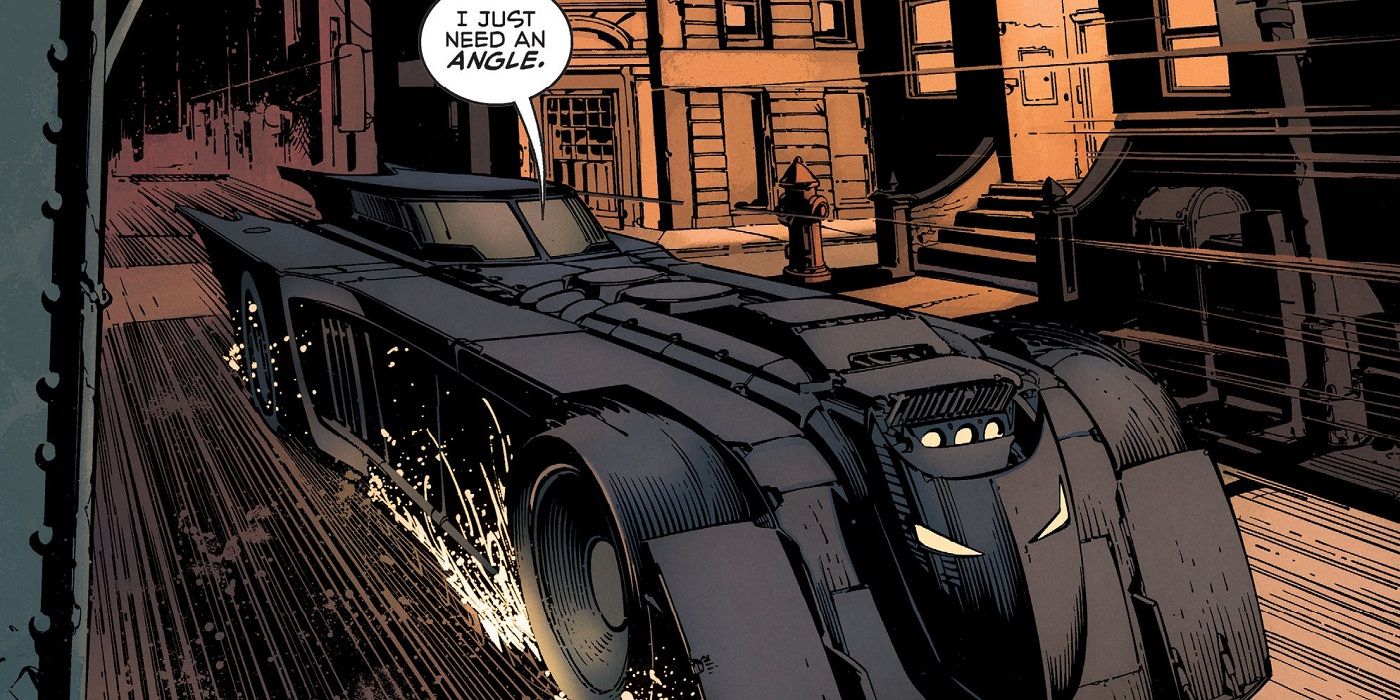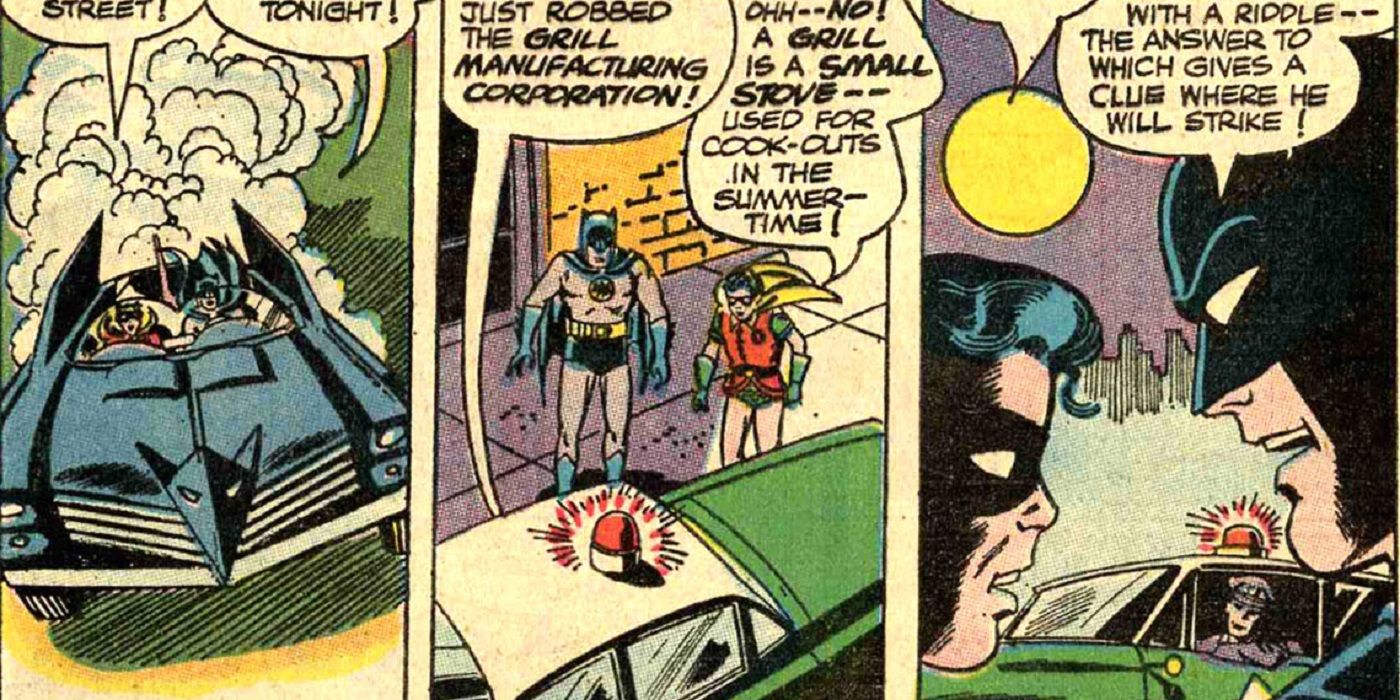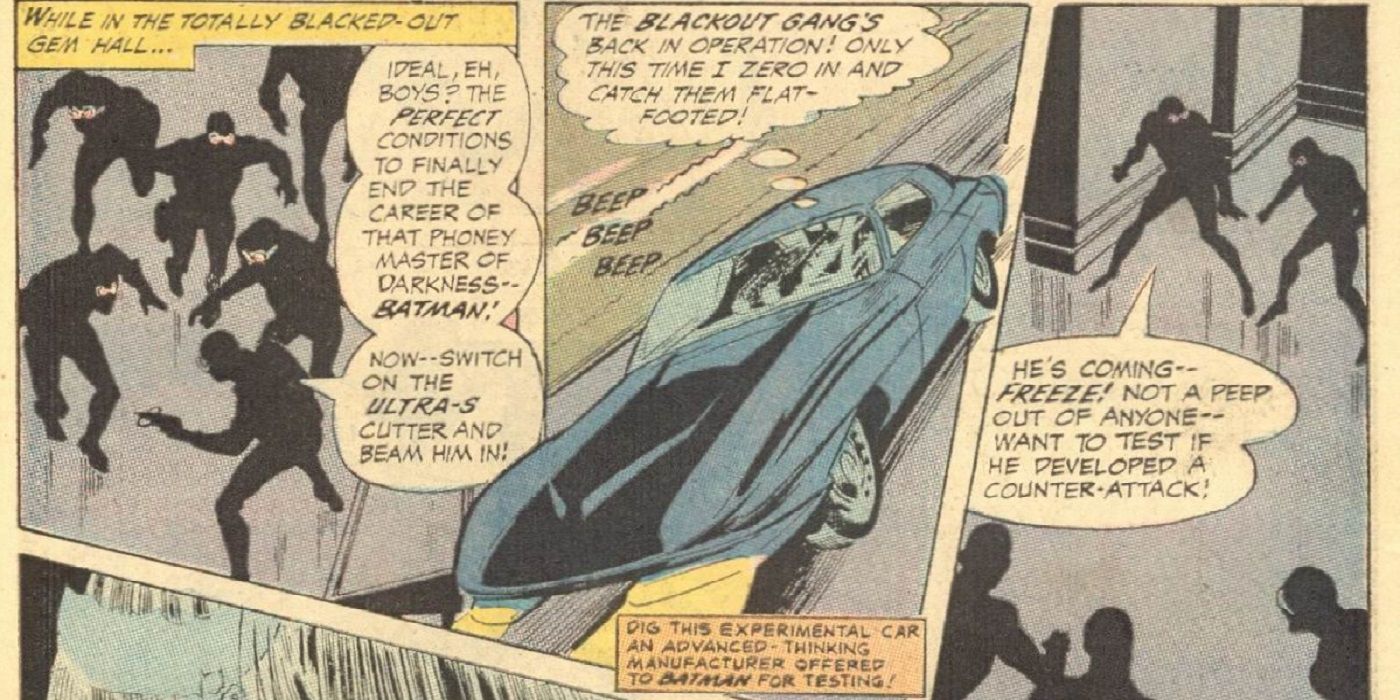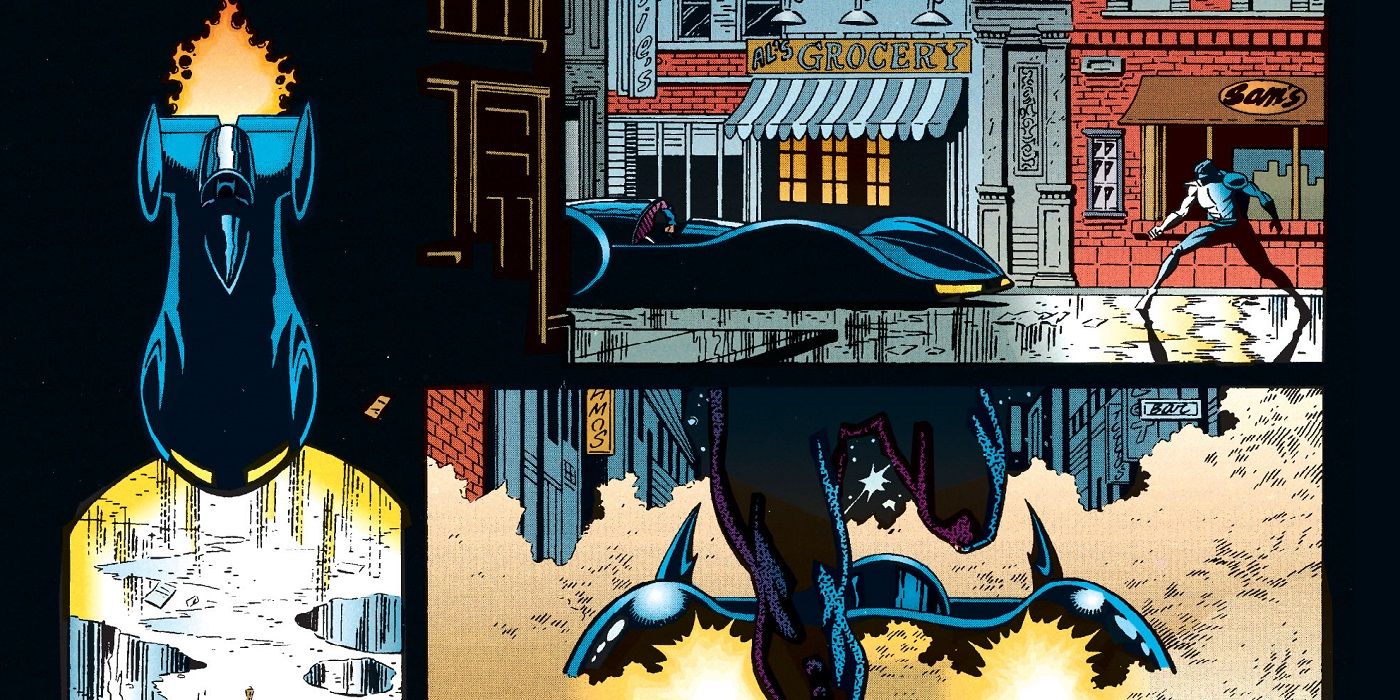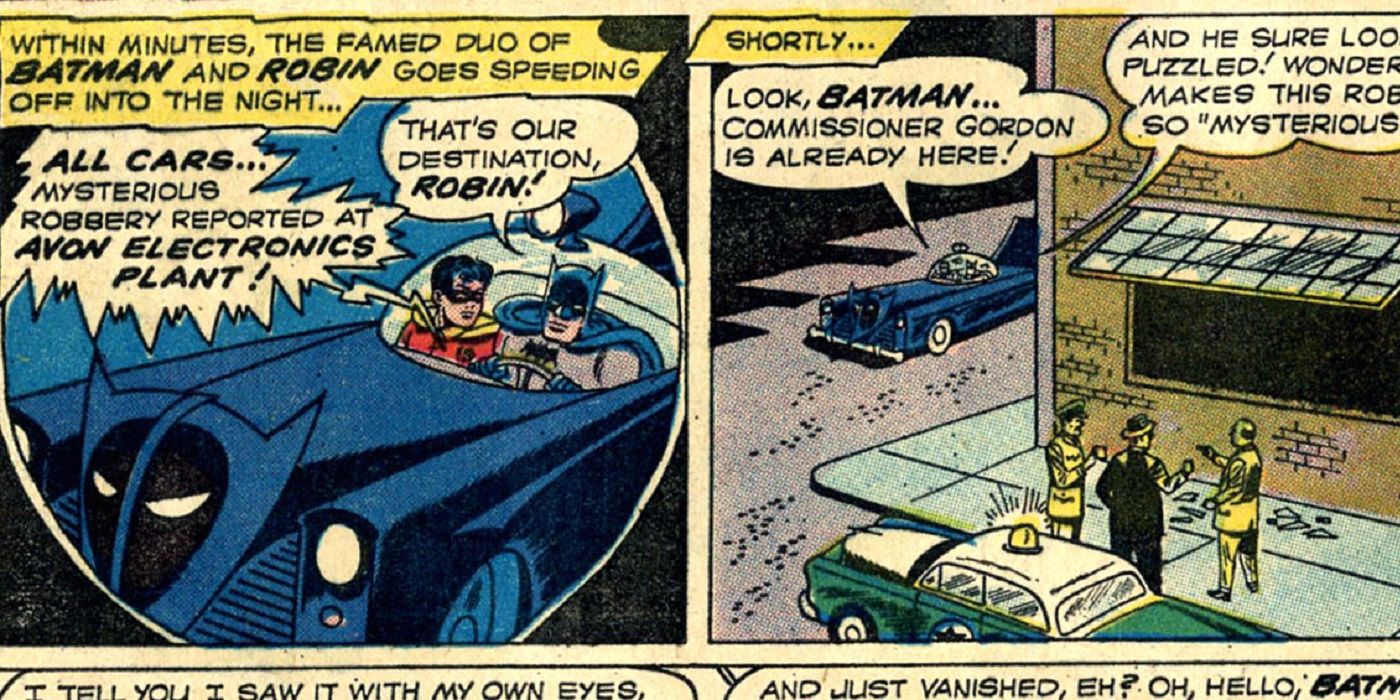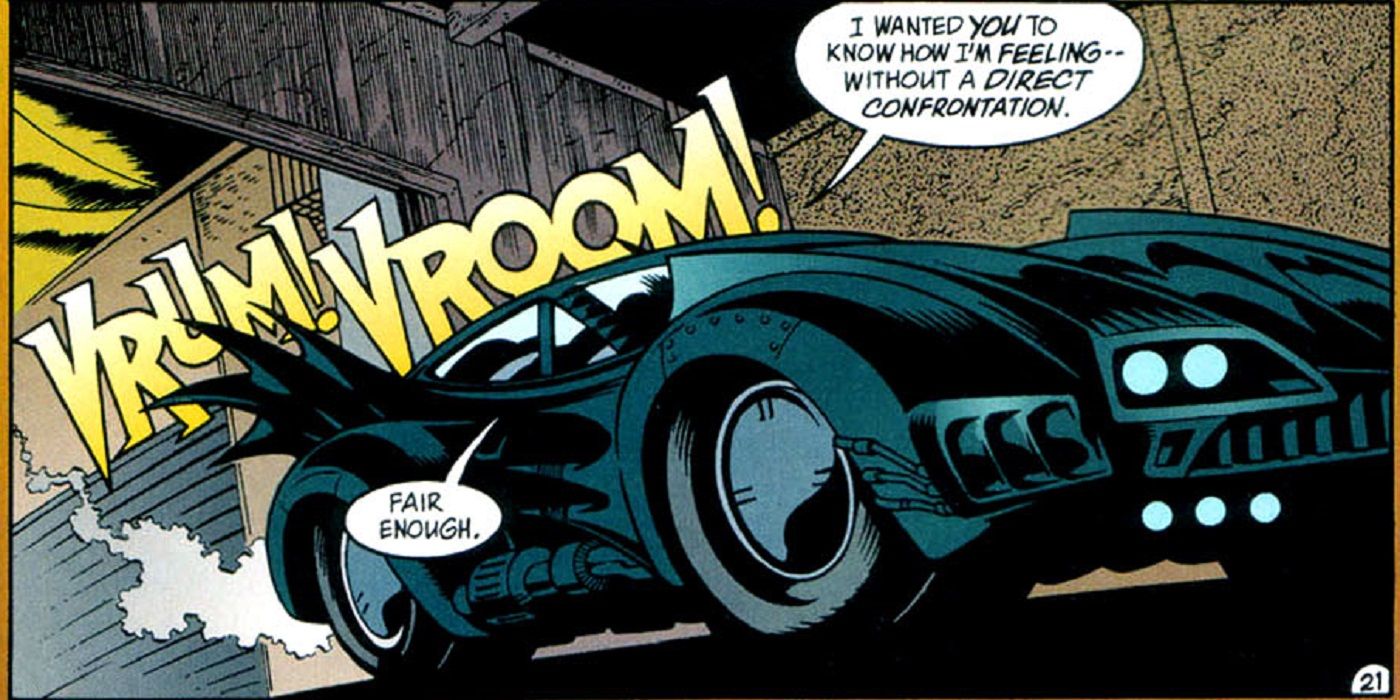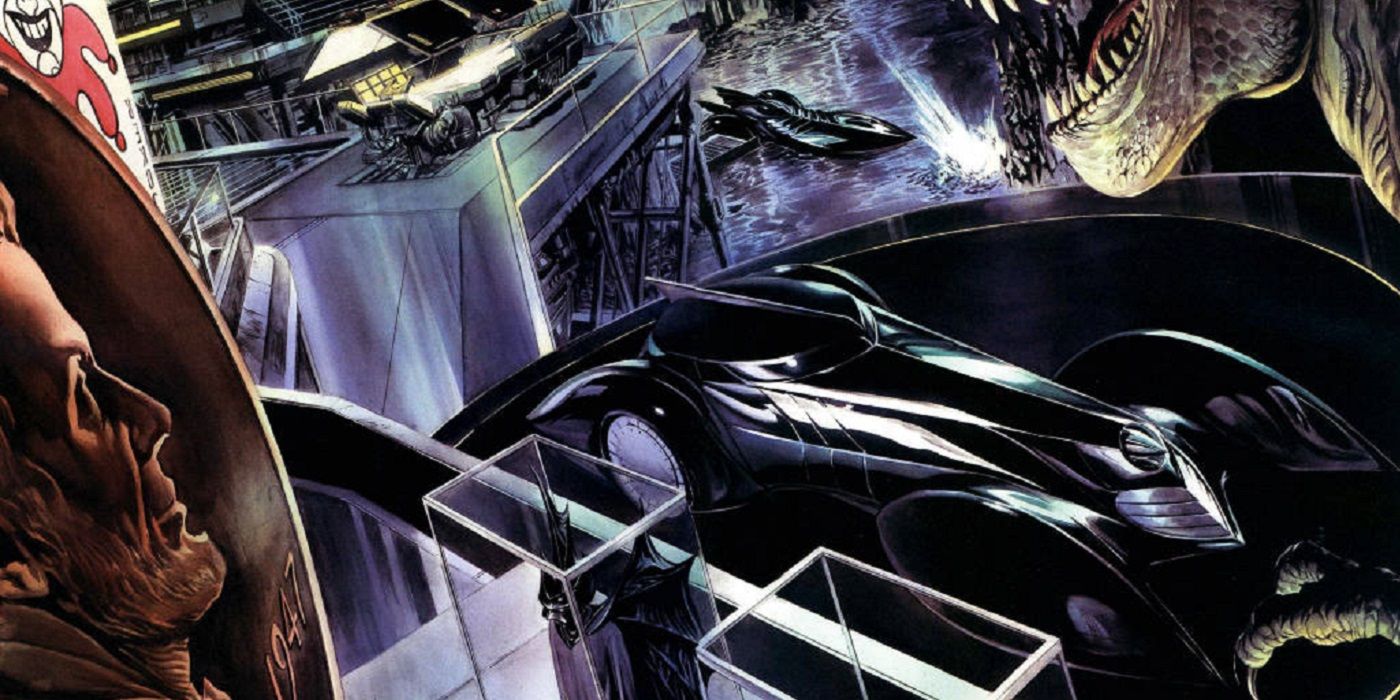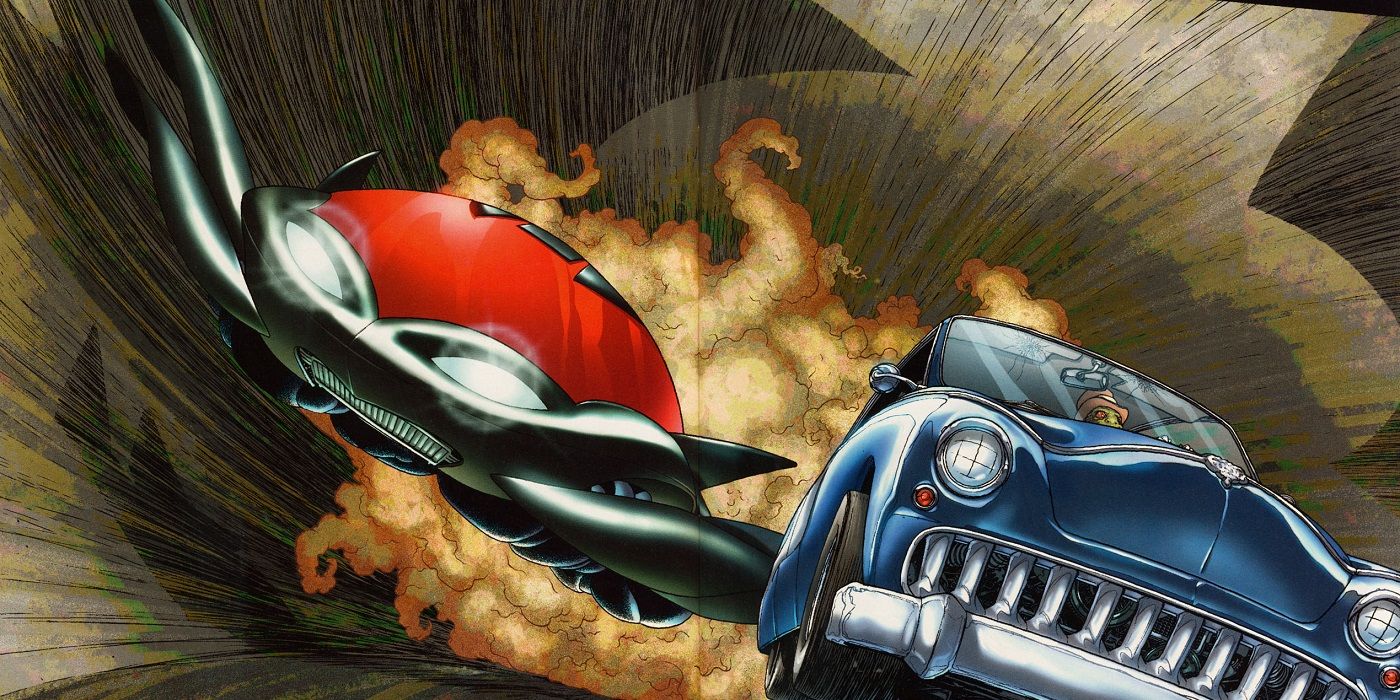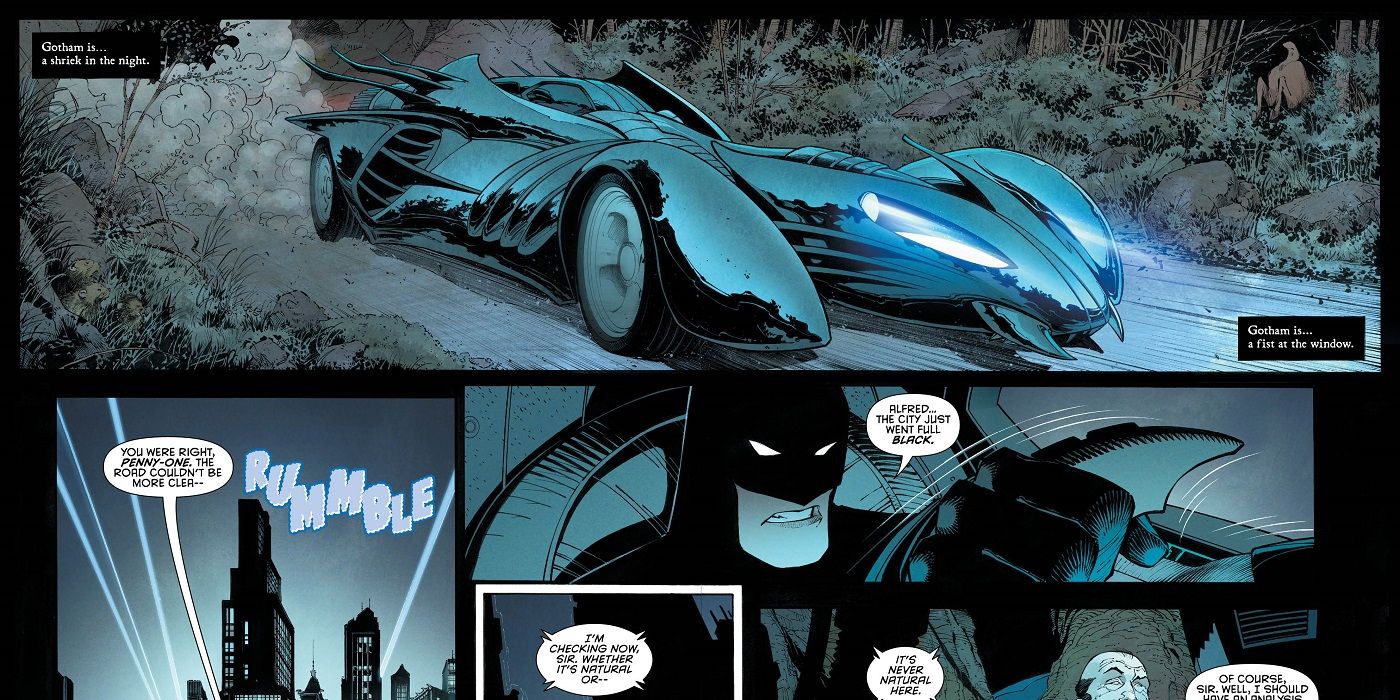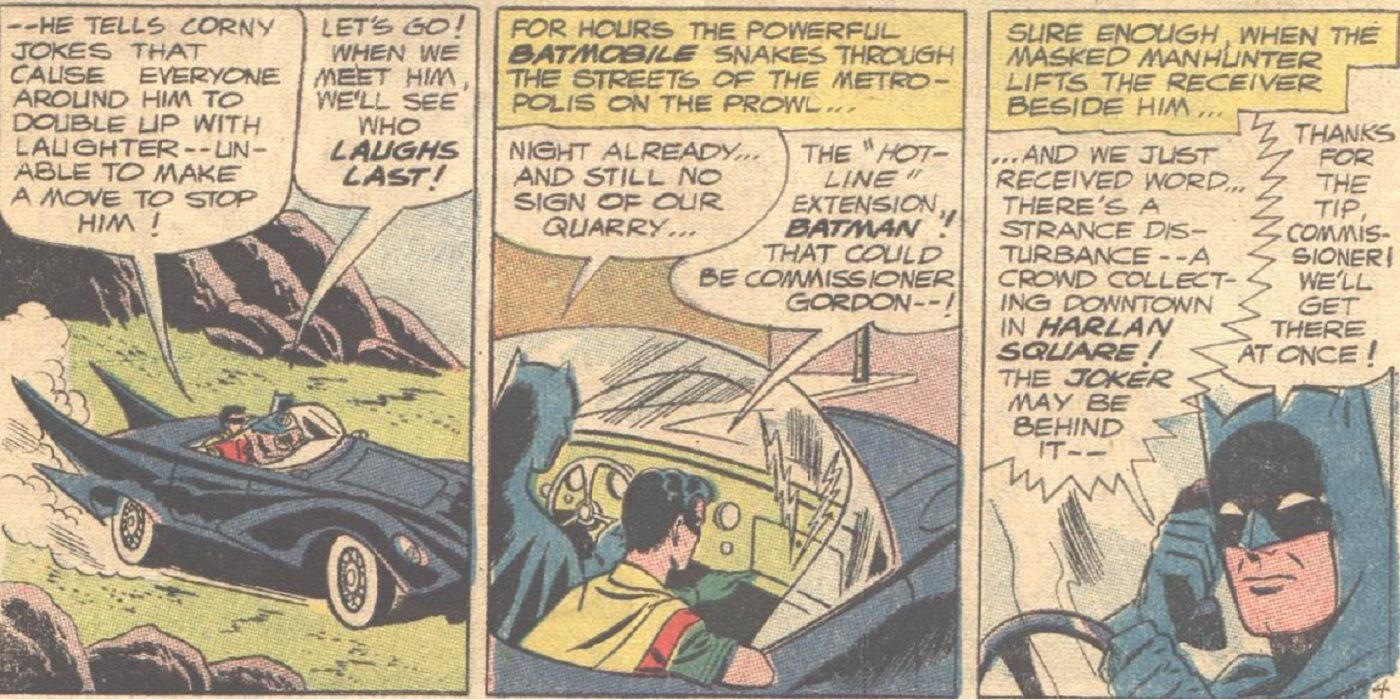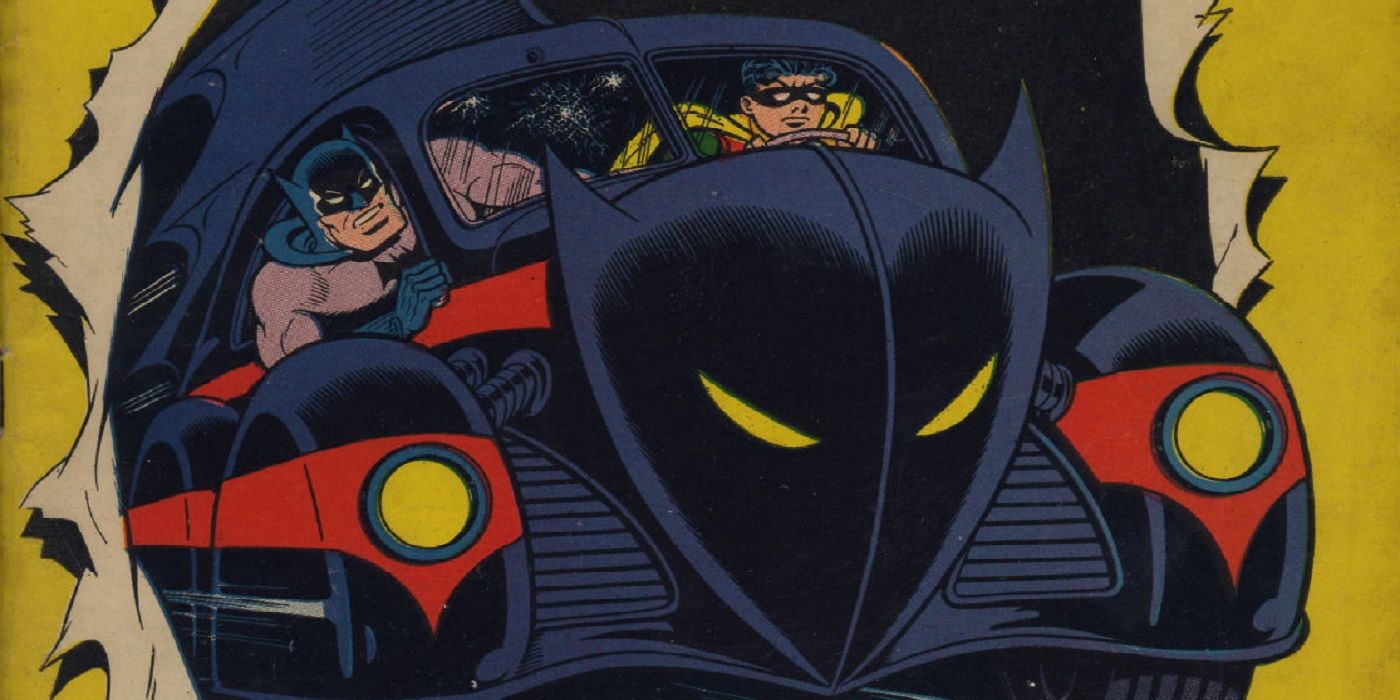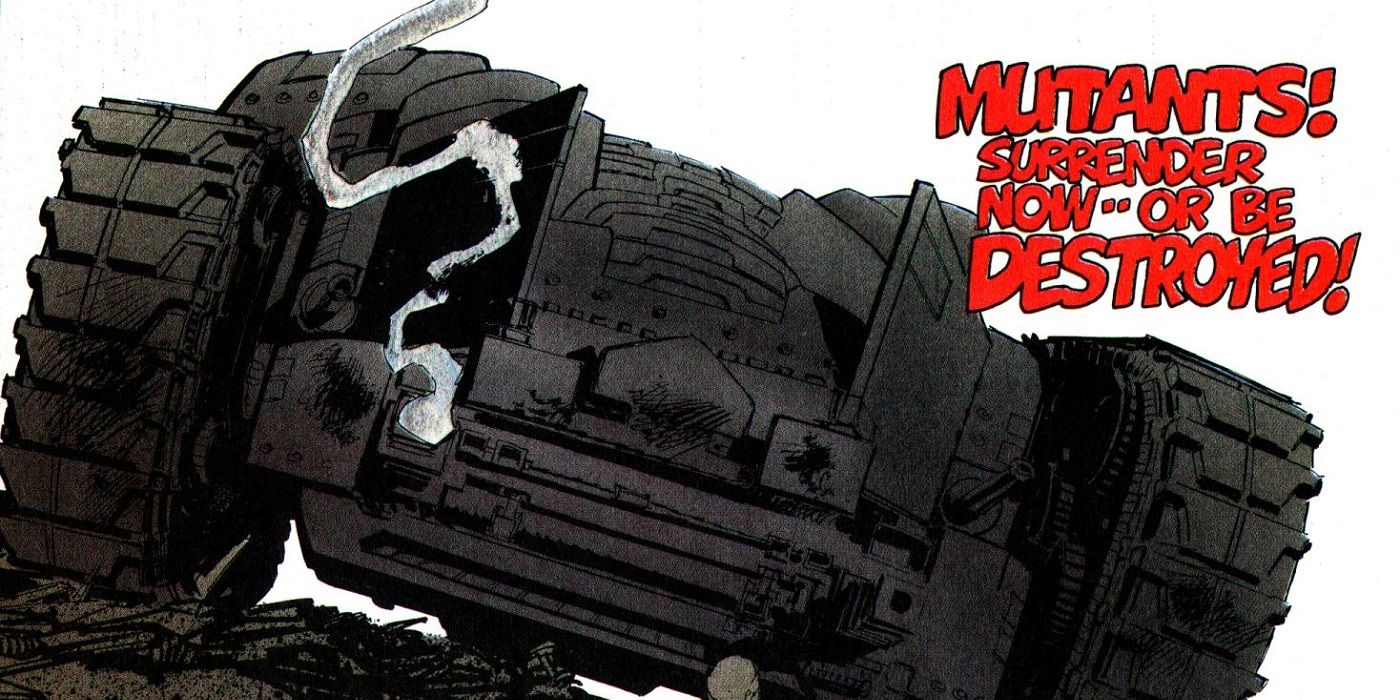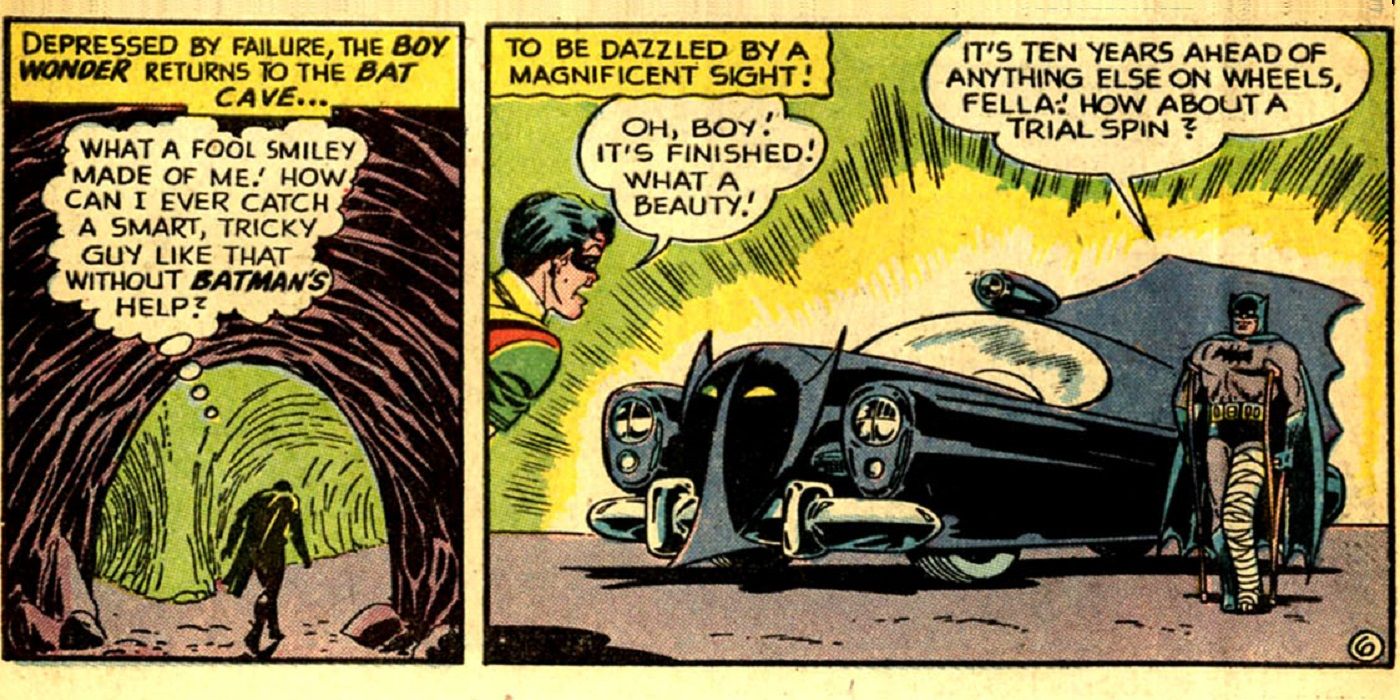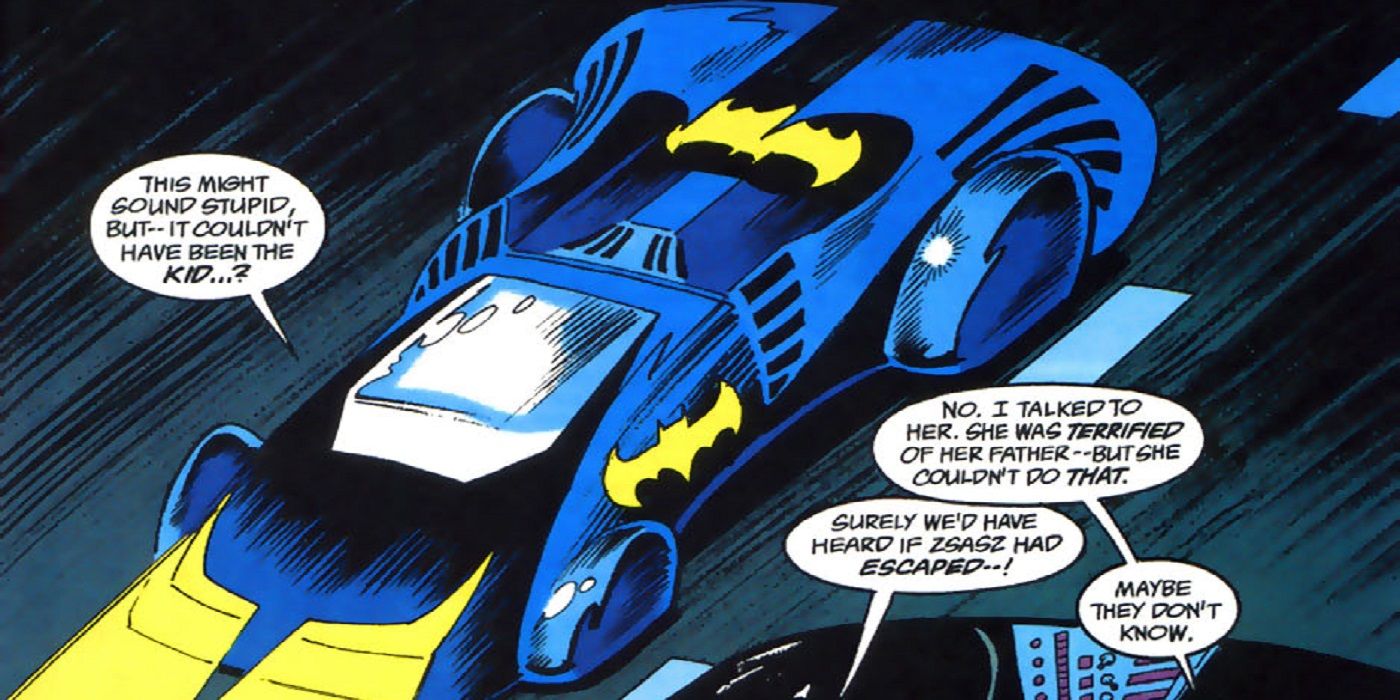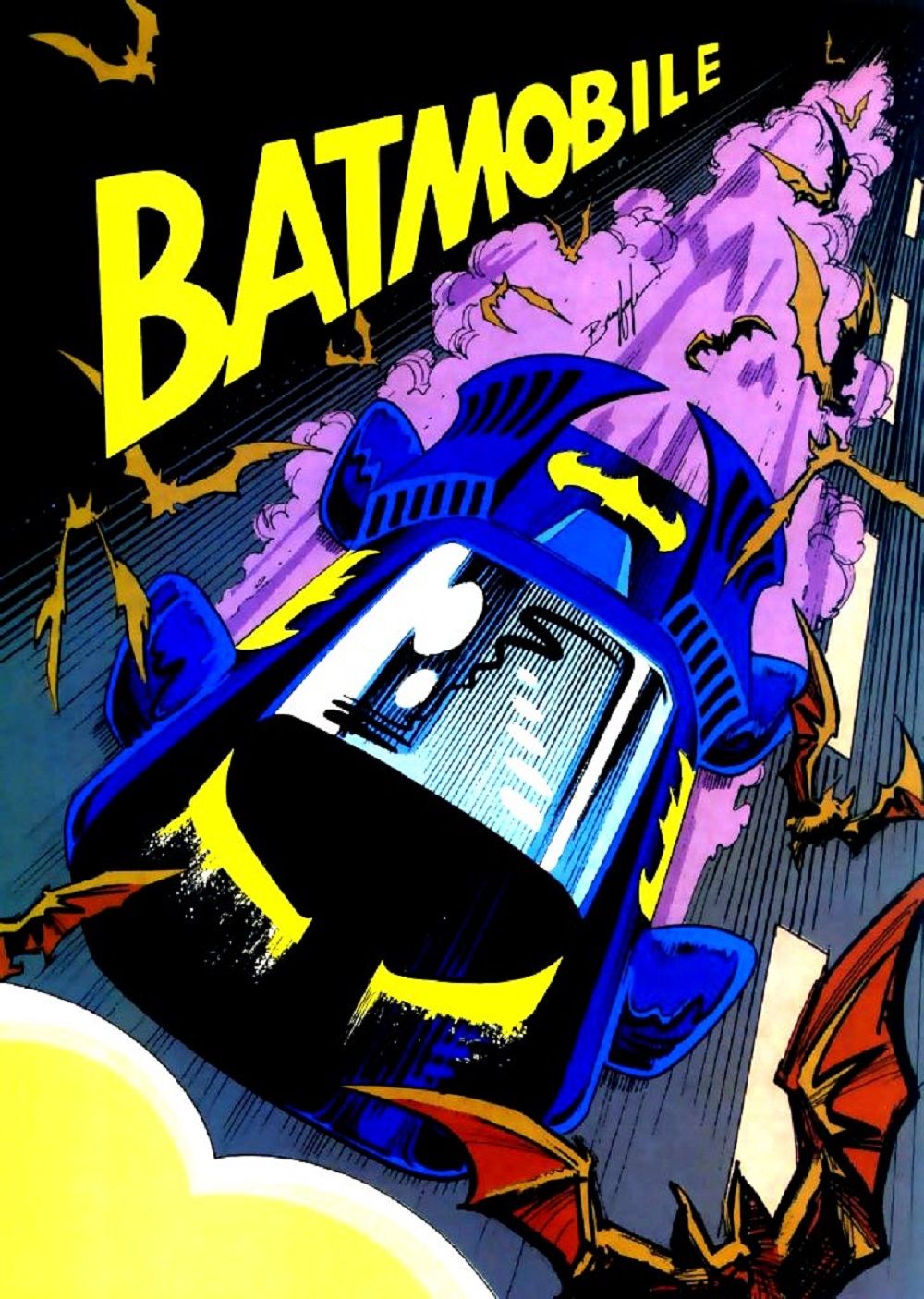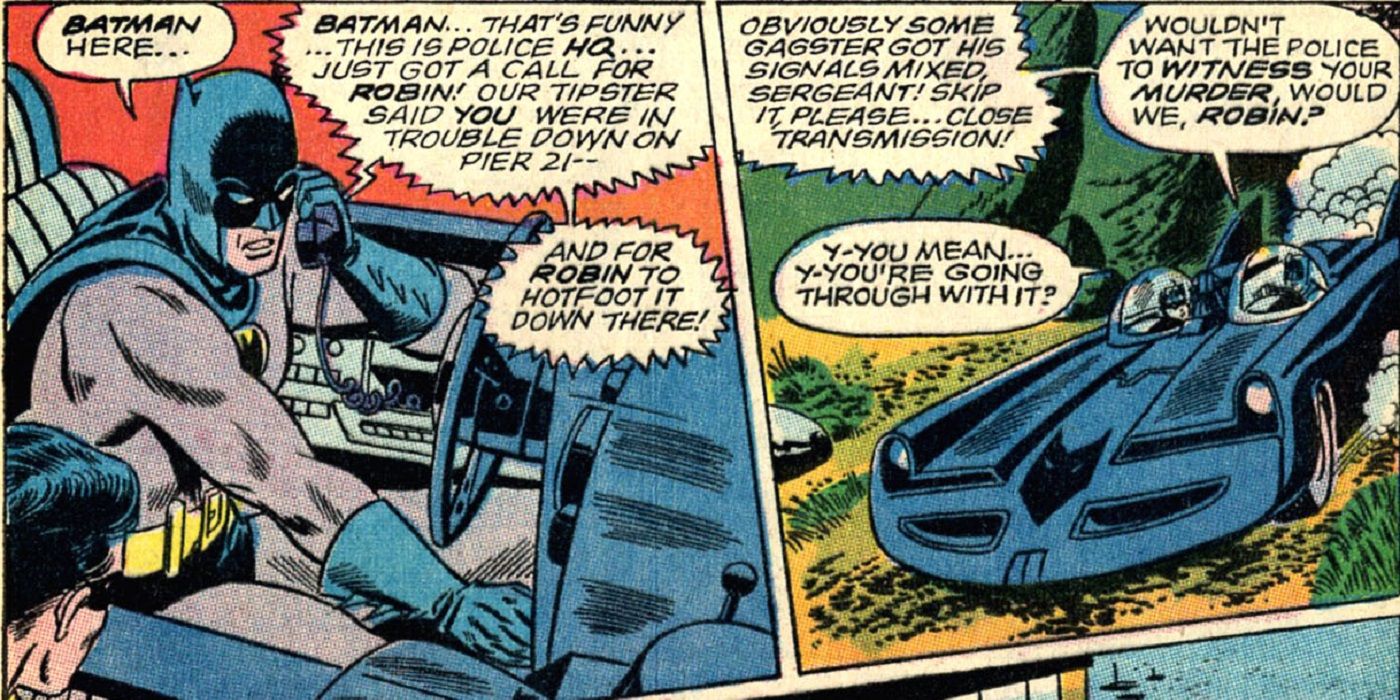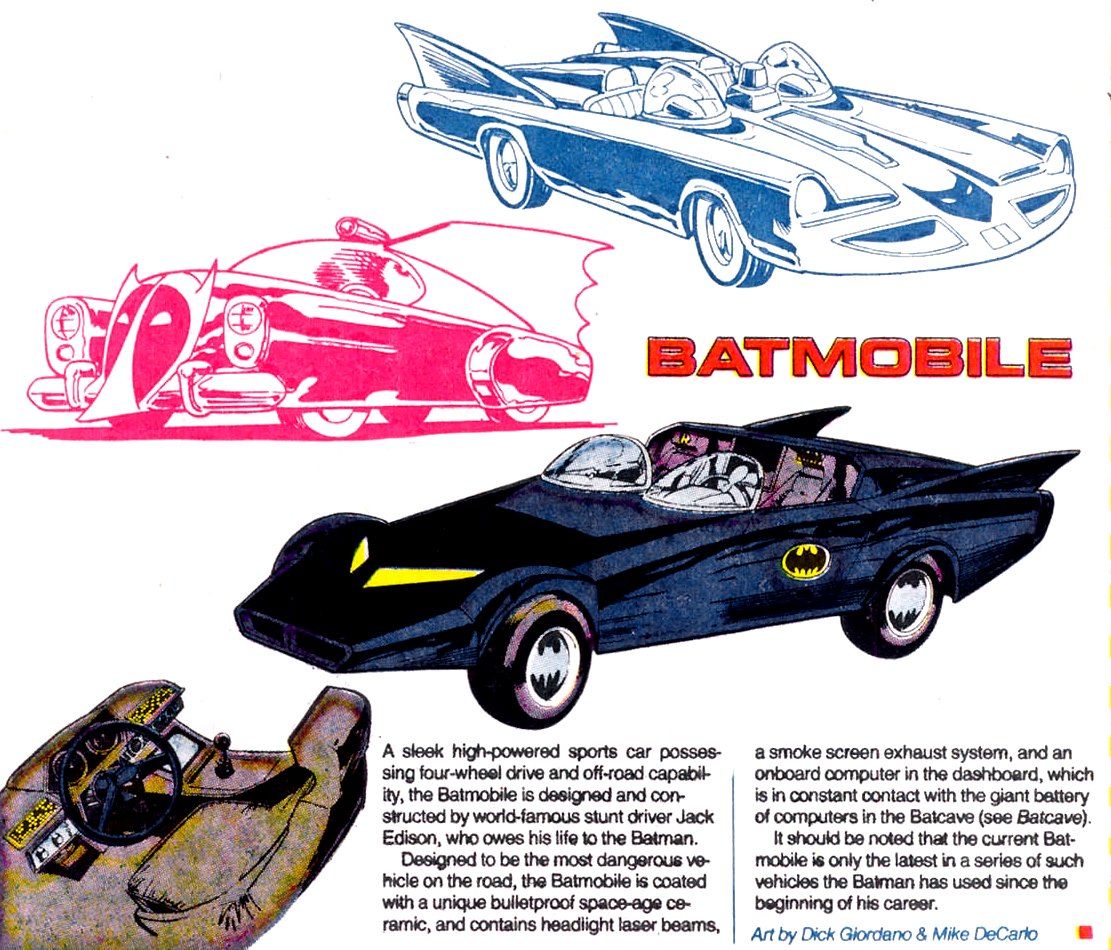One of the most interesting things about the early days of Batman's adventures is that Bob Kane and Bill Finger really didn't give a whole lot of effort into exactly what Batman's deal was besides the fact that he was a socialite who secretly fought crime at night. It wasn't until a string of issues by guest writer Gardner Fox that we first saw Batman use his utility belt, his Batarang and the first Bat-themed vehicle, the Bat-Gyro. However, Batman still just drove a regular car.
RELATED: 15 Most Iconic Batman Comic Book Covers
Soon, though, he debuted a Bat-themed car in 1941's "Batman" #5 (likely designed by Jerry Robinson) and since then, in the pages of his various comic books, Batman has burned through more cars than all of the drivers in the entire "Fast and the Furious" franchise combined. Here are his greatest comic book Batmobiles.
15 1960s ROCKET-POWERED BATMOBILE
The most famous Batmobile of them all was the George Barris-designed Batmobile for the 1966 "Batman" TV series, based on the 1955 Lincoln Futura. It was such an iconic look that it made it difficult for the artists in the "Batman" comic books that came out during the time of the show. You see, the fans who were flocking to read the comic book due to the show wanted to see the TV program's car.
Remember that sales on "Batman" comic books increased by a shocking degree thanks to TV; up until 1966, Batman was intentionally de-emphasized in the pages of "Justice League of America" to let the other heroes in the book take the spotlight. That was quickly dropped in 1966 and Batman was all over the covers of "Justice League." So, to accommodate fans, artists Sheldon Moldoff and Joe Giella gave them an approximation of it with the short-lived rocket-powered Batmobile that appeared in the comic during the run of the "Batman" TV series from 1966-1968.
14 NEAL ADAMS' BATMOBILE
When it came to Batman in the 1970s, no artist quite defined the character as much as Neal Adams did; and there were some other highly influential artists who drew Batman in that decade, like Marshall Rogers and Jose Luis Garcia-Lopez. He changed Batman's whole look, making it sleeker and more stylistic, as everything got elongated, from the ears on his cowl to his cape, which was now long enough to be used for all sorts of dramatic poses featuring the character.
As you would expect to befit an artist as important as Adams, he designed his own Batmobile for Batman, but Adams' sleek Corvette-inspired ride was pretty much confined to those issues drawn by Adams himself. The other artists mostly stuck to the then-standard design for the Batmobile, which had been implemented a few years earlier. Adams' design looks great, as does most of his artwork, but it is also a bit on the subdued side, design-wise. The car looks about as close to just a normal car as possible.
13 REBIRTH BATMOBILE
When "Batman: The Animated Series" debuted in 1992, it brilliantly wove together design elements from the 1989 "Batman" film (which featured Academy Award-winning designs by Antone Furst) with the design styles of the 1930s and 1940s. Their resulting Batmobile was a long, imposing vehicle that really stood out well.
That car design was first somewhat adopted into the comic books by artist Dustin Nguyen during Paul Dini's run on "Detective Comics" (Dini famously co-created "Batman: The Animated Series," which is likely why the car design seemed to be inspired by the cartoon series). Most recently, as part of DC Rebirth, a new Batmobile debuted that evoked the Animated Series while paying homage to the classic Batmobiles from years past with the giant "Bat face" on the front of the car. The original Furst design was to evoke "macho" car designs and that's certainly the way that the current Batmobile design comes across, as well.
12 "PREY" BATMOBILE
When "Legends of the Dark Knight" debuted in 1989 (the first new ongoing series starring Batman in decades at the time), the concept behind the book was that there would be different story arcs by different creators and the stories would be all over the place within Batman's continuity. They could be set in the present or they could be set in the early days of Batman's crimefighting career. However, that led to some confusing continuity at times.
One of ways that this was a bit confusing was when Paul Gulacy and Terry Austin debuted their take on the Batmobile in "Legends of the Dark Knight" #15, which was part of the classic Batman tale, "Prey," with writer Doug Moench. The confusing part is that the story is set in Batman's early years while the speed boat-inspired car design is a lot more modern than that. In any event, it is a cool design that other modern "Batman" artists adopted, as well.
11 1958 BATMOBILE
One of the weirdest things about the "Batman" comics of the late 1950s was the fact that Sheldon Moldoff had taken over as the main penciler on the main "Batman" titles from Dick Sprang, who had defined the character's look in the 1940s and 1950s. The reason that this was so weird is that Sprang was working as an uncredited "ghost" to Batman co-creator Bob Kane, meaning that the comic books were not credited to Sprang. However, while Kane got the credit, Sprang did not try to draw like Kane. Sprang drew his own style and that soon became the definitive look for Batman.
When Moldoff began regularly drawing "Batman," he, too, saw his work get credited to Bob Kane, but he also then had to draw in the style of Dick Sprang! So, his work was based on one artist while being credited to another artist! Thus, one of the only areas where Moldoff could put his own particular stamp on the series was with his deign of a new Batmobile, which he did. Batman used it for the rest of the 1950s and the start of the next decade. It was based on the Chrysler 300C.
10 POST-KNIGHTSEND BATMOBILE
During the Bat-crossover, "Knightfall," Jean-Paul Valley (who had been the costume vigilante known as Azrael) took over as Batman from Bruce Wayne after Wayne was severely injured in an attack by the villainous Bane. Eventually, Valley got so caught up in the role that Wayne had to heal up and return for his superhero mantle. While he was Batman, he utilized a hidden subway system underneath Gotham City to drive a special one-seater Batmobile (putting his views towards Robin in plain terms).
When Wayne returned as Batman, he then took a short vacation to recover from the whole ordeal (allowing his old partner, Dick Grayson, to temporarily fill in) and when he came back to Batman full-time, he had a new costume and a new Batmobile (designed by J.H. Williams III). It was a more down-to-Earth Batmobile than what had come before (although not designed on a specific car series) and it served Batman well for the rest of the 1990s.
9 JUSTICE BATMOBILE
The great Alex Ross had a unique approach to handling the Batmobile in comic books that might come as a bit of a surprise to comic book fans. He explained to Christopher Irving in 2011 that he intentionally wanted to keep his Batman as realistic as possible except for the existence of the Batman. Thus, he would have Batman exist without any of the extra fantastical trappings.
However, eventually Ross gave up on that approach for his 2005 miniseries, "Justice," explaining:
Of course, I eventually got away from that idea when I did Justice and said ‘He’s got the car. Here’s my design for the Batmobile.’ I was either giving up on that goal of absolute feasibility or had felt like I’d already made that statement once before. Now I wanted to draw it and put my own stamp on it.
Ross based his imposing Batmobile on roadsters from the 1940s.
8 FLYING BATMOBILE
During the crossover event, "Final Crisis," Batman was seemingly killed in a battle with the evil god of the Fourth World, Darkseid (in reality, Batman was just lost in time). Ultimately, his old partner, Dick Grayson, had to graduate to become the new Batman, partnering with Bruce Wayne's son, Damian Wayne, as the new Robin. The twist in this new team was that Robin was the more serious of the duo, as Dick still had that circus-like enthusiasm in him that served him so well when he was the original Boy Wonder.
Dick's stint as Batman also came along with a new Batmobile that embraced the future as the Frank Quitely-designed Batmobile actually flew! It was a sharp design period, but the sight of it suddenly flying after the bad guys was a striking beginning to the new "Batman and Robin" ongoing series that launched after Bruce Wayne's "death."
7 NEW 52 BATMOBILE
The first Batmobile that showed up in the comics after the 2011 launch of the New 52 (where all the DC Comics characters were relaunched in a new continuity) came in Tony Daniel's "Detective Comics" #1. It was a nice, sleek design. However, it was quickly replaced by a new Greg Capullo design that debuted in the opening arc of Capullo and Scott Snyder's "Batman" series and then lasted for the rest of the New 52.
It was a brilliant fusion of a number of different approaches in car design. It certainly maintained the futuristic look of the Quitely designed flying car, but also maintained a literally down-to-Earth approach, as well. In addition, it took the idea of the Bat symbol on the front of the earliest Batmobiles and incorporated it even further by making the front of the Batmobile as if it actually were a bat. It's a strikingly original design by Capullo.
6 NEW LOOK BATMOBILE
In 1964, the "Batman" titles were in a difficult position, sales-wise. There is some debate over just how bad the sales of the book were at the time, but whether it was literally at the point of almost being canceled or not, the main point was that something needed to change on the books and it needed to happen soon. In stepped new editor Julius Schwartz and superstar artist Carmine Infantino, who helped introduce the "New Look" Batman to signal a shift in Batman's history.
They gave Batman a new costume (a slight, but noticeable difference, with him gaining a yellow oval around the bat symbol on his chest), a new supporting cast (out were Bat-Woman, Bat-Girl and Alfred Pennyworth and in came Aunt Harriet, to add a female presence to Wayne Manor) and a new Batmobile. The new Batmobile was much sleeker and open than its predecessor and served as the inspiration for the Batmobile in the 1966 "Batman" TV series.
5 CLASSIC BATMOBILE
The first time that Batman drove an actual, clearly defined Batmobile came in "Batman" #5, but that early Jerry Robinson take on the Batmobile was unique in that it really wasn't based on a car at all. It was more a mobile battering ram than anything. Then-new "Batman" artist Dick Sprang revamped the design of the Batmobile in 1943 and turned it into something that actually looked like a real car, although he maintained the distinct battering ram-style hood of the Robinson design.
Sprang's design was featured prominently on the cover of "Batman" #20, driven by Robin for some reason, which was not explained inside the comic at all. This was the first cover appearance of the Batmobile, and perhaps due to that distinction, it became the definitive design for the Batmobile during the 1940s, although Sprang would slightly modify the design after World War II to look a bit like whatever the most recent post-War car designs looked like each year.
4 DARK KNIGHT RETURNS BATMOBILE
In 1986, Frank Miller shocked the comic book world (and the non-comic book world, as well) with the release of a prestige format miniseries that would eventually become known as "The Dark Knight Returns" (Miller was inked by Klaus Janson on the project). Set 10 years after Bruce Wayne had retired as Batman, the world had gotten so bad that Wayne had to return to being Batman. However, seeing as how he was now in his 50s, Batman had to adapt to be able to keep on fighting crime.
One of the most notable ways he achieved this was through the introduction of the new Batmobile, which was essentially a giant tank, allowing Batman to take out crooks without ever having to fight them man-to-man. Of course, this being Batman, he still felt that he had to fight them man-to-man at times, which led to one of the all-time great comic book fights between Batman and the leader of the Mutant Gang. In Jim Starlin and Bernie Wrightson's miniseries, "The Cult," Wrightson had Batman use a monster truck Batmobile that greatly evoked the Miller Batmobile.
3 1950 BATMOBILE
Modern readers are used to the idea of legacy characters and the concept of comic books acknowledging the passage of time, as it is so wrapped up in the stories that are told in modern comic books. However, for the most part, early comic books really did not show the passing of time -- that was just how it was done (just like how no one questioned why Charlie Brown never aged in decades of "Peanuts" comic strips). However, even old school comic books occasionally paid lip service to the advancement of time, and that was the driving force behind "Detective Comics" #156's "The Batmobile of 1950."
In that story, Batman's classic Batmobile is beginning to become ineffective and Batman is even injured while driving it. He then designs a brand-new Batmobile to make it the top of the line. Artist Dick Sprang based this iconic Batmobile on the then most current 1950 Studebaker and Cadillac designs. This would be the Batmobile for the rest of Sprang's tenure on the "Batman" titles.
2 EARLY 1990s BATMOBILE
As soon as he began the regular artist on "Detective Comics" in 1988, Norm Breyfogle began experimenting with new car designs, going through a number of different looks that mostly revolved around some standard ideas, like the concept of concealed wheels. The aforementioned Gulacy/Austin design became a popular one in the early 1990s "Batman" comics, as well (there was not exactly a ton of consistency on how the Batmobile should be drawn around this time), but in "Detective Comics" #601, Breyfogle debuted a car based on the Lamborghini Countach that was eventually adopted by most "Batman" artists as the main Batmobile.
Breyfogle soon adopted new approaches to the car design, as well, adding in sort of "spaceship" designs to the car, making it more and more futuristic and looking like it could reach some exceptional speeds. This was the design that Breyfogle used for DC's "Who's Who" entry for the Batmobile around this time...
But by the time Breyfogle launched "Batman: Shadow of the Bat" with writer Alan Grant, the car had reached its peak design. That was the main Batmobile used through the conclusion of Batman's return during Knightsend. It was a great-looking car.
1 POST-TV BATMAN BATMOBILE
In the late 1960s, right after the "Batman" TV series went off the air, the direction of the "Batman" books began to go darker, to try to evoke the early days of Batman's career. This direction change is often credited to writer Denny O'Neil and artist Neal Adams, but neither of them worked on the "Batman" titles until 1970. The changeover had already begun in late 1968. The earliest creators in this new style were writer Frank Robbins and artists Frank Springer and Irv Novick.
They came up with a new Batmobile that evoked that of the "Batman" TV series while giving their own personal darker spin on the design. This became the definitive Batmobile for the next 20 years, with it being adapted for "Super Friends" and other animated depictions of the Dark Knight. Obviously, there were exceptions (like Neal Adams doing his own thing), and the design of the car was slightly modified during the 1980s, with Dick Giordano depicted the modified version in DC's 1985 "Who's Who"....
But in general, this design is the closest we've come to the ultimate comic book Batmobile.
What's your favorite comic book Batmobile? Let us know in the comments section!

